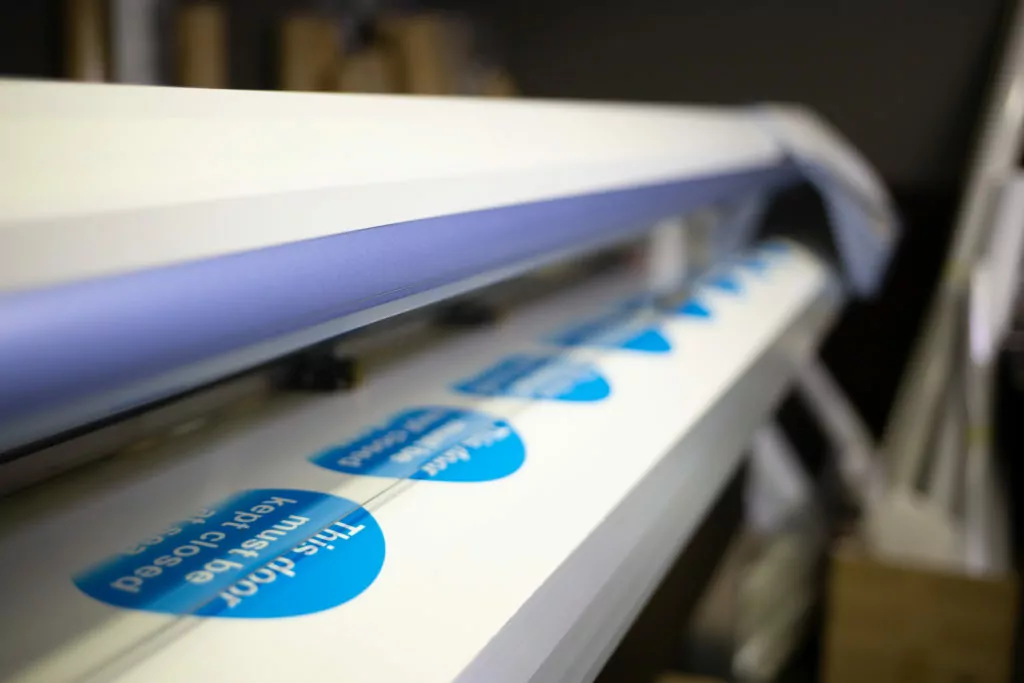Here’s how safe it is to put stickers on your laptop:
As long as you apply the right stickers to the appropriate spots, their removal shouldn’t be too much of a bother.
Plastic stickers are better than paper stickers.
You should stick your stickers on the top “clamshell” or on the back of your laptop, which is the opposite side of the screen.
If you want to learn all about whether you can self express yourself with stickers on your laptop safely, then you’re in the right place.
Let’s jump right in!

Want to Put Stickers on Your Laptop?
Today’s symbols of self-expression are no longer limited to clothing or Trapper Keeper binders.
Putting stickers on your laptop has become the contemporary way to personalize your multipurpose tool.
It might look cool, but is putting stickers on your laptop bad or unsafe?
How do you put stickers on a laptop without ruining it?
What about the style and sticker placement?
How about your laptop case?
Is this form of personalized self-expressiveness on your work laptop wrong or considered unprofessional?
Read on to explore all of the scenarios and answer any questions you may have about putting stickers on your laptop.
What Kind of Materials Do You Work With?
When wondering if putting stickers on your laptop is safe or a bad and potentially ruinous idea, it helps to know what kind of materials you’re working with.
What Is a Laptop Made Of?
A laptop computer is a petite and portable personal computer that opens up and folds down again like a clamshell.
The slim LCD or LED screen is fixed to the upper “shell,” while the keyboard is built into the lower lid.
The shell body typically consists of lightweight yet durable metals like aluminum with steel for some structures.
Most laptops’ outer shells, especially older models, are also made of plastic unless they are the super high-quality metal-only versions.
What Is a Sticker Made Of?
Stickers are a form of embellishment consisting of plastic, paper, or vinyl on one side and an adhesive on the other side that usually comes protected by a waxed paper liner until it is ready to be attached to the desired surface with a bit of pressure.

Modern-day stickers have evolved like everything else.
The popularity of scrapbooking upgraded stickers’ topside from the standard thin plastic variety to 3D, acrylic, fabric, epoxy, and puffy glittery materials.
But the adherent on the bottom side holds it in place and makes a sticker a sticker.
Plastic, Metal, and Glue: Are They Compatible and Safe?
So whether you plan to adorn your laptop with dozens of glittering stars, 3D images, or just a standard old-fashioned plastic sticker, is it safe to do so?
It depends on the type of laptop, its material, and the sticker material.
You now know the basics of what both consist of, but it can certainly vary per sticker and laptop.
A typical laptop (lightweight metal or plastic outer shell cover) and a basic sticker should be alright, just like a sticker on any surface.
Watch out for more industrial variations.
Some stickers use industrial-strength glue-like epoxy or Gorilla Glue that’s incredibly durable, strong, and can even bond steel, glass, and wood.
But that’s not what you want to get stuck on your laptop!
Paper or Plastic Sticker?
Paper stickers often have more substance on the bottom adhesive side than the top decal side.
This can also lead to them getting stuck and crumbling or flaking off if you remove them.
Think of cheap labels and price tags that you’ve had to scrape off only to be left with a pulpy mess of paper particles.
Generally, the best stickers for your laptop are the more durable glossy plastic or vinyl kind meant for such surfaces (in contrast to those designed for scrapbooks or crafts).
Bumper stickers and most band or brand stickers should be fine.
How to Remover a Sticker From Your Laptop?
Fortunately, adding a few stickers to your laptop or laptop case isn’t equivalent to getting a regrettable tattoo.
The previously mentioned paper stickers can flake and peel, so using a Goo Gone product will break down the glue (they say stickers are their bread and butter).
It’s a bit messy and pungent, though, so those stickers aren’t recommended.
For the other kinds of stickers that are meant to stay put, the adhesive may be stronger, and you might have to engage your fingernails or a tool to pry it off.
Try to remove as much as you can in one go, then peel any remaining bit off gently and wipe the residue away with rubbing alcohol.
Do not use oils, WD-40, or petroleum products on your laptop.
As long as you apply the right stickers to the appropriate spots, their removal shouldn’t be too much of a bother.
Learn below where those spots are.
But be warned that the way you attempt to remove the stickers could damage your laptop with too much zeal.
What Is the Best Laptop Sticker Placement?
So you have learned it is possible to attach decorations to your personal computer and how to put stickers on a laptop without ruining it, but where?

Laptop sticker placement isn’t only about creative design; it is crucial for your machine’s safety.
The Best Placement
The best place on a laptop to put your stickers is the top “clamshell” or back of your laptop on the opposite side of the screen.
The tough, durable, flat surface allows stickers to adhere well and stand out nicely without covering any part of the screen, keyboard, or other important functions like the various outlets and buttons.
Another spot that’s safe to put your stickers on is the flat surface on the inside of your laptop, generally below the keyboard and to the side of the built-in mousepad.
You can peel off informational and company labels that may already be there and replace them with your own or slap your stickers on top of them.
If your stickers are a bit personal or you aren’t keen to call too much public attention to yourself, the interior surface may be preferable.
The Worst Placement
Be sure the stickers are only on flat surfaces and not covering anything.
You don’t want to put stickers on your laptop to make its primary functions as a personal computer strained in any way.
This is especially important when concerning ventilation holes or other openings.
You may have noticed that after extended or extensive use, your laptop can get quite hot like it’s running a mild fever.
It’s a self-regulating machine and can normally control its temperature through the vents to cool down.
Still, the processors, graphics, and memory cards can heat up quickly, so you can’t have anything covering them or getting in the way of their cooling process.
Putting Stickers on a Laptop Case
Even if the flat surfaces of the outer shell and areas around the keyboard of your laptop are the safest places to put a sticker, for someone who has invested a lot in a prime, high-quality, expensive machine, adding such decals to the PC itself may be problematic and elicit a paranoid feeling of doing damage.
That doesn’t mean you can’t still showcase a few fun stickers if you want to.
Just pop them on your laptop case and let your personality and preferences shine without fear of harming your portable office.
Why Put Stickers on My Laptop?
Plainly put, because it’s fun! For contemporary people, our laptops are an extension of who we are, what we do, and what we like or identify with.
There’s nothing wrong with adorning your personal computer with items that reflect your personality, but there’s a time and a place for everything, even such forms of self-expression.

Like a tattoo or tee shirt with a logo, brand, or statement, what’s stuck on your laptop says a lot about you, so be sure it’s saying what you want it to say.
When and Where Is It Appropriate to Put Stickers on My Laptop?
This may come as a surprise to you, but there are times when stickers are put on even the most expensive machines on purpose as part of protecting your property.
Sadly, thievery is rampant, and a brand new laptop is a hot item.
Some people put stickers over the logos to obscure the brand of an expensive or desirable item.
Others know that a personalized laptop can “mark” it and deter theft.
Of course, it’s not all for the purpose of not having your prized possession stolen.
Most people choose to put stickers on their laptops to announce their interests or affiliations, make their devices more identifiable in a crowd, and add a dash of personality to their PCs. Think of it as decorating your office.
When and Where Isn’t It Appropriate to Put Stickers on My Laptop?
For those looking to resell their laptops or who are borrowing a PC from another owner, it’s best to keep it clean.
Think of it like a car or a rental apartment; alterations and damage can affect the value and require compensation or repairs.
Vice cautioned against stickers that could be deemed controversial in any setting, particularly for journalists and international travelers who have to run their laptops through security.
You don’t want to inadvertently raise red flags or label yourself as a target, however unintentionally.
It’s fabulous to express yourself, but best to stay away from anything that might make others uncomfortable when using your laptop in a public place. Is that really the kind of attention you want to attract while trying to get your work done?
Laptop Stickers in the Workplace: Expressive or Unprofessional?
You may be concerned that putting stickers on a work laptop would be deemed unprofessional.
Not necessarily. It really depends on your work environment and circumstances.
Generally speaking, personalizing a work laptop provided to you is a big no-no, because it’s considered company property.
However, there’s no reason to suppress your individuality if your own personal computer and the environment are welcoming, even encouraging.
But read the room first. If no one else has a laptop full of decals, you might want to keep it clean too.

